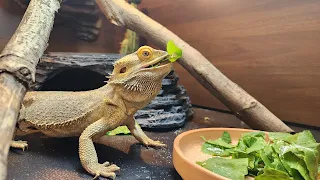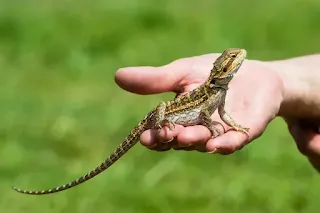How to Make Your Reptile Feel at Home: Comfort Tips for New Pets
Welcoming a new reptile into your life is an exciting experience. These unique creatures bring a sense of fascination and tranquility to any household. However, reptiles require a carefully crafted environment to feel secure, thrive, and display their natural behaviors. This guide provides practical tips to help your reptile feel at home and build a bond of trust with its new owner.
Understand Your Reptile's Needs
- Research the Species
Learn about your reptile's natural environment—desert, forest, aquatic, or grassland.
Understand whether your reptile is nocturnal, diurnal, or crepuscular to mimic its active hours in captivity.
- Behavioral Traits
Observe if your reptile prefers climbing, burrowing, or basking.
Some reptiles are naturally shy and require extra hiding spaces, while others are more social and curious.
By understanding these aspects, you can tailor the environment and interactions to suit your pet's specific preferences.
Create the Perfect Habitat
- Choose the Right Enclosure
Size: Ensure the enclosure is spacious enough for your reptile to move, climb, or burrow freely.
Material: Glass tanks work well for visibility and humidity control, while wooden vivariums are better for retaining heat.
Ventilation: Provide adequate airflow to prevent mold and maintain air quality.
- Interior Design
Add branches, rocks, and plants to mimic your reptile's native environment.
Create multiple hiding spots using caves, logs, or artificial decor to provide security.
Include climbing structures if your reptile is arboreal.
- Humidity and Temperature Control
Use hygrometers and thermometers to monitor levels consistently.
Install misting systems or water bowls to maintain humidity for tropical species.
A habitat that reflects your reptile's natural surroundings will reduce stress and encourage normal behavior.
Establish a Feeding Routine
- Know Your Reptile's Diet
Herbivores: Offer fresh greens, vegetables, and occasional fruits. Kale, dandelion greens, and butternut squash are excellent choices.
Insectivores: Feed gut-loaded crickets, mealworms, or dubia roaches to ensure maximum nutrition.
Carnivores: Provide pre-killed rodents or fish, depending on your reptile's species.
Omnivores: Mix protein sources with leafy greens and veggies.
- Feeding Tips
Offer food at consistent times to establish a routine.
Use feeding tongs to avoid accidental bites and build trust.
Monitor portion sizes to prevent overfeeding, which can lead to obesity and health issues.
- Hydration
Always provide clean, fresh water in a shallow dish.
Misting the enclosure or using a dripper system can encourage reptiles that drink from droplets.
Meeting nutritional needs consistently fosters trust and keeps your pet healthy.
Handle with Care
- Start Slowly
Allow your reptile time to acclimate to its new environment before attempting to handle it.
Observe its behavior—signs of stress include hissing, hiding, or tail thrashing.
- Proper Techniques
Support your reptile’s entire body, especially the tail and abdomen.
Avoid grabbing from above, as this can mimic predator behavior and cause fear.
Limit handling sessions to 10–15 minutes initially and gradually increase the duration.
- Building Trust
Hand-feed treats to create positive associations.
Spend time near the enclosure to let your reptile get used to your presence.
Be consistent and gentle to ensure a stress-free experience.
Proper handling not only enhances your relationship but also allows you to monitor your reptile’s health closely.
Enrichment and Stimulation
- Interactive Elements
Introduce climbing branches, tunnels, or ramps to encourage exploration.
Rotate decor regularly to keep the environment stimulating.
- Out-of-Enclosure Time
Set up a safe, enclosed area for your reptile to explore under supervision.
Use reptile harnesses for species that can be taken outdoors, ensuring safety at all times.
- Feeding as Enrichment
Use feeding puzzles or scatter food around the enclosure to encourage natural hunting behaviors.
Keeping your reptile mentally stimulated prevents boredom and enhances its quality of life.
Monitor Health and Behavior
- Signs of a Healthy Reptile
Clear, bright eyes and smooth skin.
Regular feeding and elimination habits.
Active and alert behavior during its active hours.
- Common Health Concerns
Watch for signs of respiratory infections, such as wheezing or mucus.
Look for abnormalities in shedding, such as retained skin.
Consult a vet if you notice lethargy, loss of appetite, or unusual behaviors.
- Regular Checkups
Schedule routine visits with a veterinarian specializing in exotic animals.
Keep records of your reptile’s weight, shedding patterns, and feeding habits.
A proactive approach to health care ensures your reptile remains happy and comfortable.
Build a Routine for Interaction
Consistency in daily routines can help your reptile feel secure and reduce stress.
- Establishing Patterns
Turn enclosure lights on and off at the same time each day to mimic a natural day-night cycle.
Feed your reptile at regular intervals to create a predictable routine.
Handle or interact with your reptile at the same times each week to build trust.
- Observe Behavior
Learn your reptile’s activity patterns and avoid disturbing it during rest periods.
Note changes in behavior that may indicate stress or health issues.
Creating a stable routine fosters a sense of safety and comfort for your pet.
Final Thoughts
Creating a comfortable environment for your reptile is a rewarding journey that requires understanding, patience, and dedication. By addressing its specific needs, providing a stimulating habitat, and building a strong bond, you’ll help your reptile thrive in its new home. Remember, a happy reptile is a healthy reptile, and the effort you invest will be repaid with years of companionship and fascination. Start implementing these tips today, and watch your reptile settle into its perfect home with ease !









